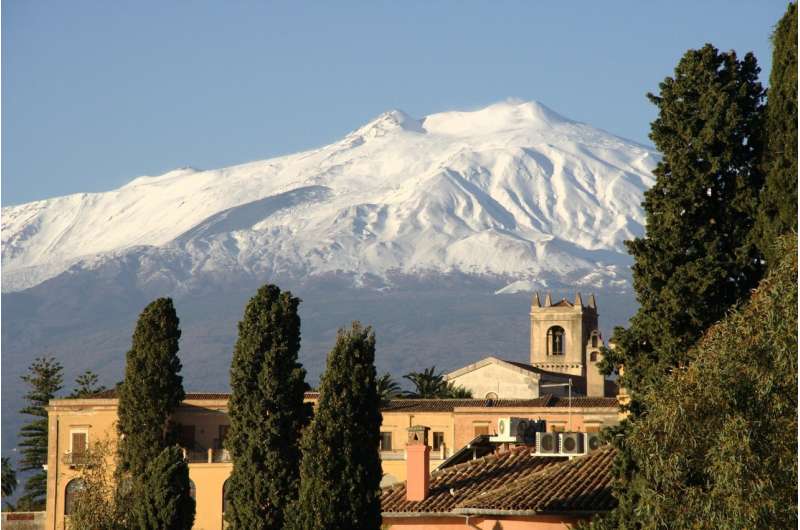Mount Etna’s exceptional carbon dioxide emissions are triggered by deep reservoirs of the gas

The transport of carbon dioxide stored in the Earth’s lithospheric mantle beneath the Hyblean Plateau in southern Italy at a depth of approximately 50 to 150 kilometers is responsible for the exceptionally large CO2 emission of Mount Etna. That is the result of research conducted by an international team of geologists, including researchers from the Universities of Florence (Italy) and Cologne (Germany), and from the Istituto di Geologia Ambientale e Geoingegneria of the Italian National Research Council (CNR). To reach this conclusion, the team determined the ratios of a particular set of elements in the magmas emitted by the volcanoes using cutting-edge, high-precision measurement methods. The results have been published in the article “A carbon-rich lithospheric mantle as a source for the large CO2 emissions of Etna volcano (Italy)’ in the journal Geology.
Over the geological times, variations in atmospheric CO2 depended mainly on volcanic emissions, which are difficult to estimate because they are not directly related to the volume of the magmas erupted. Indeed, some volcanoes show exceptionally large emission of CO2 when compared to the amount that can be dissolved in their magmas. Etna is perhaps the most striking example, contributing to 10 per cent (9000 tons/day) of the present global volcanic CO2 emission. That is three times more CO2 than a volcano like Kilauea (Hawaii) emits, which erupts four times more magma.
The team investigated magmas from four volcanoes in the region (Etna, Vulture, Stromboli, and Pantelleria), using the two rare elements Niobium (Nb) and Tantalum (Ta) as tracers. Ratios of Nb/Ta are very constant in many rocks and are only modified by few geological processes—like the infiltration of carbonate-rich melts in Earth’s mantle. The study revealed that magmas from Mount Etna and Mount Vulture are characterized by extremely high Nb/Ta ratios, higher than any other active intraplate volcano. This means that the magma compositions testify to the presence of lithospheric mantle domains beneath southern Italy that are extremely enriched in carbon. This carbon is ‘tapped’ during the melting of the magmas.
The process is directly related to the region’s complex geodynamic setting: The carbon-rich lithospheric mantle domains are located beneath the Hyblean Plateau in southern Sicily. These domains are transported towards the region beneath Etna by means of tectonic activity, specifically the rollback of the Ionian subduction plate. A symmetric mechanism is likely occurring on the other side of the Ionian plate, beneath Mount Vulture.
“The data also allow us to infer the contribution of such carbon-rich domains to the Earth’s atmosphere in the past, suggesting that the CO2 emissions of Mount Etna during its ancient activity might have been even higher than at present,” Professor Dr. Carsten Münker from the University of Cologne’s Institute of Geology and Mineralogy commented. He and his team were responsible for the high precision measurements including the two critical elements Nb and Ta.
Lead author Dr. Alessandro Bragagni, former postdoc at Cologne and now at the University of Florence, added that “similar carbon-rich domains might be hidden beneath other volcanoes worldwide, hence contributing to their CO2 emissions. The innovative trace element approach used in this study represents a promising way to better estimate the contribution of carbon-enriched lithosphere to overall volcanic CO2 emissions, both at present and in the past, which may have played a key role in changing the climate of our planet.”
Volcanologist suggests Mt. Etna behaves more like a giant hot spring than a volcano
Alessandro Bragagni et al, A carbon-rich lithospheric mantle as a source for the large CO2 emissions of Etna volcano (Italy), Geology (2022). DOI: 10.1130/G49510.1
Citation:
Mount Etna’s exceptional carbon dioxide emissions are triggered by deep reservoirs of the gas (2022, January 20)
retrieved 21 January 2022
from https://phys.org/news/2022-01-mount-etna-exceptional-carbon-dioxide.html
This document is subject to copyright. Apart from any fair dealing for the purpose of private study or research, no
part may be reproduced without the written permission. The content is provided for information purposes only.
For all the latest Science News Click Here
For the latest news and updates, follow us on Google News.

